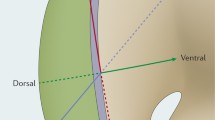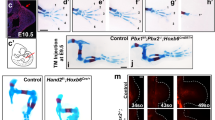Abstract
Limb patterning is thought to be a multistep process involving specification of the limb fields, establishment of defined signaling centers that globally inform cells of their position, interpretation of positional signals, and regulated growth and differentiation of the limb structures. Great progress has been made over the past few years in identifying the molecular players that control limb outgrowth and patterning, in particular, how the limb axes are specified. However, the molecular mechanism for determination of the morphological and functional differences between forelimbs and hindlimbs has remained elusive. The recent identification of a series of limb-specific transcription factors has now provided excellent candidates for such upstream regulators of limb identity, and has allowed new insights into the regulatory network of making a hand or a foot.
Similar content being viewed by others
Author information
Authors and Affiliations
Additional information
Received: 24 August 1998 / Accepted: 23 September 1998
Rights and permissions
About this article
Cite this article
Simon, HG. T-box genes and the formation of vertebrate forelimb- and hindlimb specific pattern. Cell Tissue Res 296, 57–66 (1999). https://doi.org/10.1007/s004410051266
Issue Date:
DOI: https://doi.org/10.1007/s004410051266




